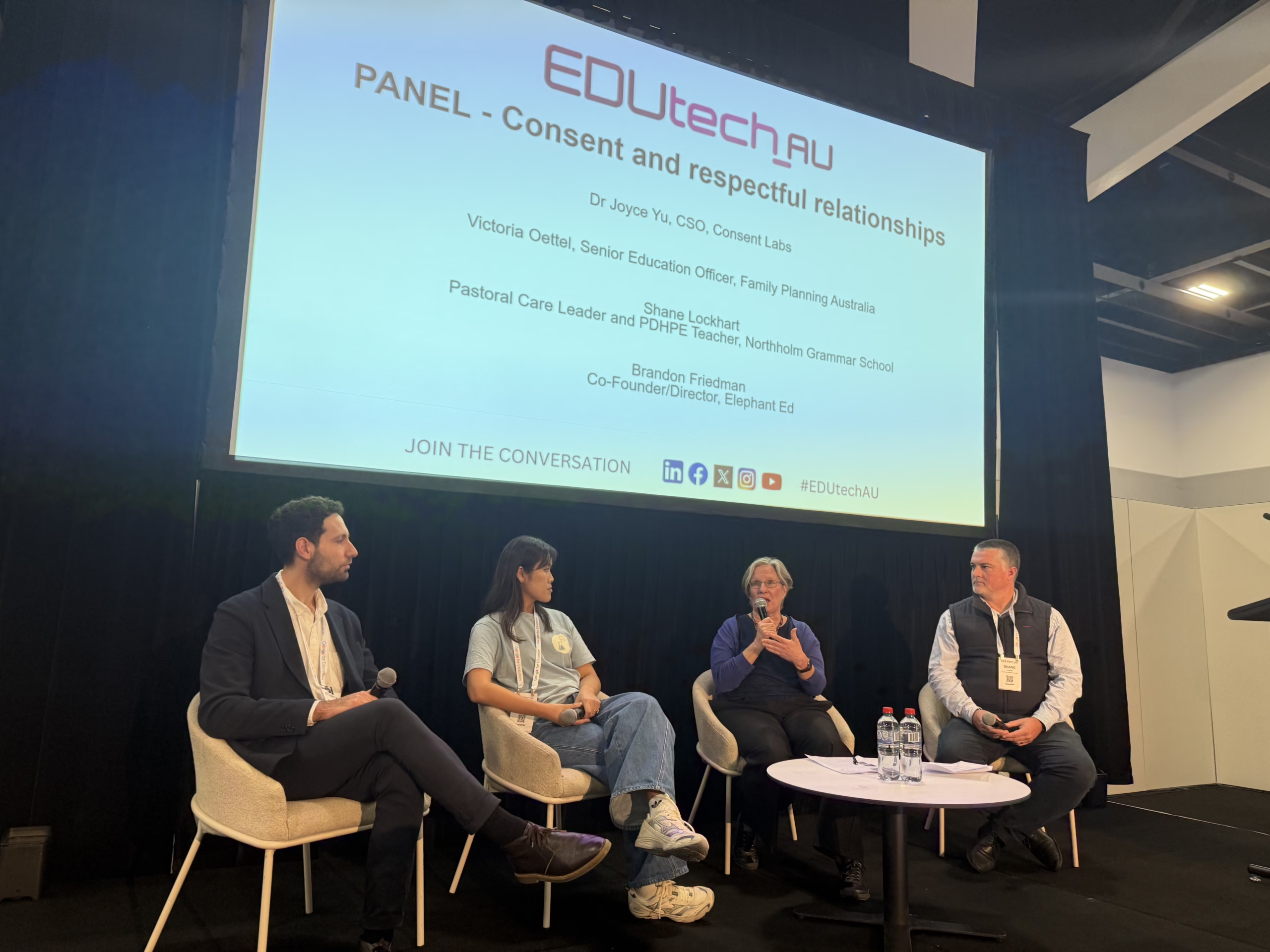
The scope of sexuality education, or ‘sex ed’, has grown significantly since its introduction in Australian schools over a century ago.
Teaching consent has become a focus area in the curriculum in recent years, expanding the remit of sex ed beyond anatomy and ‘the talk’ that so many young people dread.
Our Senior Educator, Victoria Oettel, joined leading industry peers at EDUtech 2025 for a panel, ‘Consent and respectful relationships’, to discuss best practice in teaching students this topic both in the classroom and outside of it.
The panel discussion, moderated by Northolm Grammar School Pastoral Care Leader and Personal Development, Health and Physical Education (PDHPE) teacher Shane Lockhart, featured Consent Labs Co-Founder, Director and Chief of Strategy Dr Joyce Yu and Elephant Ed Director and Co-Founder Brandon Friedman, who offered fantastic insights and knowledge from different education lenses.
We cover the key takeaways in this blog – read on to learn more.
Curriculums covering consent are key, but it takes more than textbooks to teach it
Consent is often misunderstood as a topic that only needs to be discussed with adolescents in PDHPE classes once they become sexually active. This isn’t the case.
Conversations of consent often appear in our social lives, whether it’s asking for permission to have a bite of your friend’s lunch or to ask for a hug when you’re feeling down.
It’s important for children to be introduced to the concept of consent from an early age, starting in lower primary and beginning with related themes. For example, consent for others to use their toys or join games and needing permission to touch people or not letting people touch you without this permission.
Countless similar teachable moments pop up in the playground, at home, and wherever else a child may go. Use these to encourage positive behaviours.
The earlier kids learn how to set and respect boundaries, the better equipped they are to understand and respect both their bodies and the bodies of those around them.
The principles of consent are absorbed by children far more effectively in environments where they feel supported and respected by adults and educators. Ensure students not only know where they can go for non-judgemental advice or help but feel comfortable seeking it too.
As the leading provider of reproductive and sexual health education for schools and teachers, Family Planning Australia runs regular courses and webinars for teachers on topics including consent and healthy relationships. Head to our training pages to find the full list of upcoming courses.
Gendered learning is the exception, not the rule
When covering certain topics, like positive masculinity, it may be more effective and impactful to separate classes by gender. Likewise, cultural considerations or trauma informed practices may indicate that gender sensitive groupings can be helpful to create supportive learning environments for teaching some topics in some situations. However, this shouldn’t be common practice when teaching young people about consent and healthy relationships.
The stereotype that girls are victims and boys are oppressors is not helpful, and we risk promoting it when dividing learning experiences by gender.
Consent is not gendered, and it’s important for developing minds to hear other perspectives and experiences beyond their own.
If a class feels too full to teach everyone at once, try creating smaller groups instead. This facilitates intimate, inclusive discussions where everyone gets a chance to speak and have their voice heard.
When taking the small group approach, encourage all participants to speak up and practice conversations about consent. Scenario-based lessons are a good way to get students chatting.
These can be done in the third person to avoid any potential embarrassment or feelings of shame. Introduce different scenarios and ask your students questions like: How should someone respond in this situation? What can people do to listen more effectively?
Family Planning Australia has created an acclaimed discussion card game aimed at secondary students called The Game: Consent, Sex and Relationships to help learning in the classroom. Visit our online shop to check it out.
Principles of consent matter more than the places they may be challenged
As technology has evolved, so too – unfortunately – have the environments where kids may encounter negative situations that damage their trust or break their boundaries. The proliferation of nude and sexual images online, including those that are AI generated, is a prominent example of this.
It can be tempting to try and enforce bans on device and internet use to combat this. However, this isn’t an effective solution. Technology is in every aspect of our lives in the 21st century, and it’s no use trying to circumvent this reality.
Different and rapidly changing environments don’t mean we need to reinvent the wheel when it comes to teaching children about consent and healthy relationships, because the fundamental principles remain the same.
It’s essential to teach young people critical thinking skills. Encourage your students to thoughtfully consider what they’re consuming online and question who they’re speaking to, what they’re saying, what they’re sharing and how they’d like to be treated in interactions with other people.
It takes a village to teach consent
The onus can’t be on PDHPE teachers alone to teach students about boundaries and healthy relationships.
While PDHPE curriculums are key to teaching children and adolescents about their bodies and respectful relationships, learning must go beyond these classes for positive behaviours to emerge and grow.
It’s the collective responsibility of teachers, parents, families and guardians to act as role models and mentors to children as they grow up and navigate personal boundaries and relationships.
Family Planning Australia has created some great resources tailored to school leaders, teachers, wellbeing staff and parents. Read these now on NSW Health’s Play Safe Pro website.